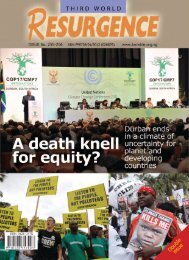Plantations, poverty and power - Critical Information Collective
Plantations, poverty and power - Critical Information Collective
Plantations, poverty and power - Critical Information Collective
You also want an ePaper? Increase the reach of your titles
YUMPU automatically turns print PDFs into web optimized ePapers that Google loves.
110<br />
Friends of the Earth International’s 2006 report notes that “[T]he EIB remains one of the least transparent<br />
<strong>and</strong> least accountable institutions within the EU.”561 Anders Lustgarden, of the Bretton Woods Project<br />
describes the EIB as a “huge black hole in the middle of EU development policy”.562<br />
Although the pulp <strong>and</strong> paper sector does not form a major part of the EIB’s lending, the Bank’s loans to<br />
Veracel clearly illustrate the problems with the Bank’s involvement in this sector. While the project led to<br />
a series of lucrative contracts for European companies, Veracel’s vast areas of plantations have destroyed<br />
local livelihoods, leading to increased migration from the area. (See section on Veracel, above.)<br />
In June 2003, EIB agreed to fund the expansion of a controversial pulp <strong>and</strong> paper operation in the Slovak<br />
Republic. The SCP Neusiedler paper mill (owned by Mondi) is notorious in the area for the stink which<br />
hangs over the town of Ruzonberok. When the World Bank’s IFC announced that it was considering a<br />
loan to exp<strong>and</strong> the paper mill’s capacity, local people protested, pointing out the pollution from the mill.<br />
After IFC dropped the project, EIB stepped in with a loan for €64 million.563 EIB announced the loan<br />
after the loan agreement had been signed, allowing local people no chance to protest.564<br />
The EIB provided a €245 million loan for the Stendal pulp mill in Germany. The project went ahead<br />
despite industry overcapacity in Europe. The main justification for the project was that it created jobs.<br />
The project created 580 direct jobs <strong>and</strong> 1,000 indirect jobs. As CIFOR notes, in its report on financing<br />
pulp projects, given the total project cost of €1 billion, “the cost of creating these jobs was high, <strong>and</strong> there<br />
must have been political considerations – such as promoting the integration of Eastern Germany into the<br />
EU – that also played a role.”565<br />
Stendal is in the former Eastern Germany. After German reunification, a nuclear <strong>power</strong> plant in Stendal<br />
was closed down. The pulp mill was intended to replace the jobs lost in the nuclear <strong>power</strong> plant.<br />
Other EIB loans to the pulp <strong>and</strong> paper sector include:<br />
•€211 million to Svenska Cellulosa Aktiebolaget (SCA) for research <strong>and</strong> development (under appraisal,<br />
July 2008).566<br />
•€43.7 million to Sociedad Anónima Industrias Celulosa Aragonesa (SAICA) for research <strong>and</strong><br />
development <strong>and</strong> to convert a paper machine to use waste paper as raw material (2008).567<br />
561 Jaroslava Colajacomo (2006) “The EIB in the South: In whose interest”,Friends of the Earth International,<br />
Campagna per la Riforma Banca Mondiale, CEE Bankwatch Network, World Economy, Ecology <strong>and</strong> Development,<br />
January 2006, page 5.<br />
562 Heather Stewart (2008) “The shadowy bank that has loaned £150bn of your cash”, The Observer, 2 March 2008.<br />
http://www.guardian.co.uk/business/2008/mar/02/europeanbanks.worldbank<br />
563 “European Investment Bank lends EUR 64 million for increasing paper production in Slovakia”, European<br />
Investment Bank press release, 26 June 2003. http://www.eib.org/projects/press/2003/2003-070-eur-64-mio-for-increasingpaper-production-in-slovakia.htm<br />
564 “The IFC’s ‘no’ to controversial Slovak paper mill followed by the EIB’s ‘yes’”, Bankwatch Mail 21, 7 June 2004.<br />
http://www.bankwatch.org/publications/mail.shtmlx=221879<br />
565 Machteld Spek (2006) “Financing pulp mills: an appraisal of risk assessment <strong>and</strong> safeguard procedures”, Center for<br />
International Forestry Research (CIFOR) , page 25.<br />
566 “SCA Hygiene Product <strong>and</strong> Packaging RDI”, EIB website, 25 July 2008.<br />
http://www.eib.org/projects/pipeline/2008/20080270.htm<br />
567 “SAICA Venizel”, EIB website, 17 December 2007. http://www.eib.org/projects/pipeline/2007/20070293.htm















